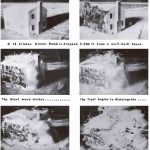The Emergency Elevator Repair Service
Nov 1, 2017

One of the first attempts to address the use of elevators during a non-fire emergency
The subject of elevator use in emergency situations has been discussed — and debated — by industry members for more than 100 years. These discussions have often been driven by contemporary events that shaped the cultural context of these conversations and the definitions of what constituted an “emergency.” Few eras of modern history rival the early 1950s in regard to concerns about the potential for widespread catastrophe and mass destruction and the need to articulate an appropriate emergency response. The development of nuclear weapons and the advent of the Cold War had a dramatic impact on American society. These events also elicited a unique response from the vertical-transportation industry.
In early 1952, the National Association of Elevator Contractors (NAEC) established a special committee charged with the task of preparing a preliminary study of the possible roles and responsibilities of industry members in the event of a nuclear attack. America’s nuclear superiority had lasted a brief four years after the bombing of Hiroshima and Nagasaki in August 1945: on August 29, 1949, the Soviet Union conducted its first successful test of a nuclear bomb. This escalation, coupled with the start of the Korean War in June 1950, prompted President Harry S. Truman to issue Executive Order 10186, which established the Federal Civil Defense Administration (FCDA). The next year, Congress passed legislation confirming the creation of FCDA. Over the next two years, nuclear weapons testing continued: on November 1, 1952, the U.S. conducted the first test of a thermonuclear or hydrogen bomb, which was 500 times more powerful than the bomb dropped on Nagasaki; one year later, the Soviet Union tested its version of the hydrogen bomb.
The NAEC special committee was chaired by ELEVATOR WORLD founder William C. Sturgeon, who, like many of his generation, had served in the military during World War II. In the early 1950s, Sturgeon was also serving as the civil defense director of Mobile, Alabama, and, in this capacity, he attended numerous FCDA planning meetings and witnessed several nuclear bomb tests at the Nevada Proving Grounds. Thus, he had firsthand knowledge of the destructive power of nuclear weapons, as well as the proposed operation of FCDA. The NAEC committee’s draft report, completed in early 1953 and published in the March and May 1953 issues of EW, recommended the creation of the Emergency Elevator Repair Service (EERS). The committee intended to submit its report to the National Elevator Industry, Inc. (NEII®) and the International Union of Elevator Constructors (IUEC) for review and comment prior to submitting the report to FCDA.
Unfortunately, no record exists of the NEII or IUEC response, nor is there any record of its submission to the FDCA. Nonetheless, its contents offer a unique view of an early strategy for addressing elevator use in emergency situations. Much of the report embodies, viewed from a present-day perspective, an extremely optimistic assessment of the capability of the U.S. and the elevator industry to survive a nuclear attack. However, embedded in this (perhaps unrealistic) assessment was the outline of a cogent plan regarding emergency elevator use.
The activities of the EERS were divided into three distinct categories: pre attack, attack and post attack. The signal that would have launched the EERS into action would have been the sound of air-raid sirens. During this brief pre-attack period, the group’s critical objectives included transporting people with disabilities to safe areas:
“Elevators must be used to transport occupants who are physically incapable of using the stairways and can be of great service in transporting other occupants of the building to designated safe areas, as well as transporting transients from the street to safe areas. Therefore, they should be kept in service until these activities have been carried out or until the warden in chargedecides that a part, or all of theelevators, need to be taken out ofservice. A schedule should be prepared in advance which the elevators must follow while in air-raid service. This schedule should be so arranged as to most effectively transport passengers fromthe various floors to the safeareas.”[1]
The description of this activity is interesting in its reference to the presence of “safe areas” within a building. Although the physical characteristics of these areas were left to the reader’s imagination (and it is hard to imagine how they could have protected inhabitants from nuclear fallout), this appears to be an early appearance of the “area of refuge” concept: a space where occupants would gather until they could be rescued or an emergency had passed.
The schedule for elevator operation during the pre-attack period was predicated on an analysis of the building’s population and an estimation of the surrounding transient population:
“Consideration should be given to the number of occupants on the various floors and the capacities and number of cars serving those floors. Approximate data should be prepared as to the number of trips and time required to clear the respective floors. This will require complete information as to floor population, capacity, type and performance of the elevators and estimate of the probable number of transients. It will be desirable to consult qualified elevator engineers regarding these studies.”[1]
The recommendation to consult a “qualified elevator engineer” suggests that they would perform the calculations necessary to determine an elevator system’s capacity to transport passengers to safe areas within a limited period of operation.
The proposed schedule for transporting passengers during an air raid was predicated on three principles:
- “The quickest way to move groups of passengers to safe areas is to make two stops on each trip, one when they are loaded, and one when they are unloaded.
- “Cars should take their first loads from floors furthest from the safety zones, giving preference to clearing the top floors. As soon as the remaining occupants of a floor are insufficient in number to quickly fill the cars, some or all of the cars serving that floor should be shifted to the next floor on schedule.
- “Where one group of cars serves all floors in a building, the group should be divided, part to transport occupants to safe areas from the top floors, and part to transport occupants and transients to safe areas from the lower floors.”[1]
It is important to remember that most elevators in the early 1950s used operators. Their presence constituted a readily available team that could ensure an emergency operation schedule would be followed. The NAEC committee did, however, recognize the need to account for the recent appearance of “operatorless” elevators:
“In case of automatic push-button self-service elevators, which ordinarily are operated by the passengers themselves, an emergency guard, appointed by the warden in charge, should be assigned to police the operation of the car.”[1]
Lastly, the committee provided guidelines for use of service or freight elevators to transport passengers:
“If freight elevators must be used for transferring occupants to safe areas, the number of persons who can safely be carried on one trip should be posted in the car. The operator should not carry more than this number, as an overload may stall the car or cause overspeed.”[1]
This proposed operation strategy appears to have been one of the first attempts to describe the use of elevators during a non-fire emergency.
The NAEC report also included guidelines for car location after all passengers had been delivered to safe areas and the attack had begun:
“All cars, with the exception of those which are required for ground-floor emergency service, should be parked in the safe areas. When the car is parked, the operator should open the emergency circuit, shut down the motor-generator set, turn out the lights and remain with the car, keeping the door of the car open.”[1]
These directions highlight the value of the older system of elevator operation, which required an operator. Actual elevator use during an attack would be limited to transporting injured passengers to first-aid stations, transporting emergency personnel and – if the elevators were “enclosed in fireproof hoistways” – evacuating the building’s occupants in the event of a fire.
After the air raid was over, the EERS was responsible for returning a building’s elevator system to full operation (if possible). The guidelines for this process addressed the possibility of power failure and trapped passengers:
“In case of power failure, the control circuit should be opened. When power is restored, motor-generator sets should be started one at a time. The occupants should be advised that elevators are usually installed in the least vulnerable parts of the building, and, in the event of stopping between floors because of a power failure, they should remain calm and stay in the car until power is restored and the car can be moved to a landing. Very little harm can come to passengers as long as they are in the car, but accidents may occur in attempting to escape from the car.
“Specific instructions will be posted in order that elevator passengers who are trapped within the elevator car due to power failure will be acquainted with the fact that they are to remain within the car until authorized personnel directs them in being transferred to a particular floor from the car. It will be the responsibility of EERS to designate and train responsible individuals in each building in the proper procedure for handling such an emergency.”[1]
If a building’s elevators could be brought back into service, it was recommended that “motor-generator sets be started one at a time to minimize peaks in the power system and possible opening of circuit breakers or fuses.” The next step was to operate the cars without passengers to ensure that they were “in good operating condition.”
A revised version of the NAEC report was published in the February 1955 issue of EW. The revisions were required because of the steadily increasing destructive power of nuclear weapons:
“The magnitude of recently developed weapons have made it necessary for the FCDA to advise that tactical evacuation is the primary means of defense, and all staff planning for defense should take this basic concept into consideration.”[1]
Although the revised report included information related to the evacuation – and return – of EERS teams to “targeted cities,” it retained the detailed plans for elevator use before, during and after an air raid. Intriguingly, the article’s introduction stated that the report had been “utilized as a planning guide by a number of target cities.”[2] Future research into individual city FCDA plans might reveal the presence of the EERS scheme, as well as other strategies.
The plan’s republication in 1955 was accompanied by a cover illustration of a nuclear bomb test and a series of photos depicting the complete destruction – in 2.3 s. – of a test house located 3,500 ft. from ground zero (Figures 1 and 2). The photographs were taken during the test of “Annie,” a 16-kiloton bomb detonated from a 300-ft.-tall steel tower at the Nevada Proving Grounds on March 17, 1953. This was the first test open to Civil Defense members and was likely the first nuclear explosion witnessed by Sturgeon. This experience, and these chilling images, served as the impetus for the development of the EERS plan and serve as reminder of the awesome destructive power of nuclear weapons.
- Figure 1: EW, February 1955, cover
- Figure 2: Photographs of house destruction with original 1955 captions, “Emergency Elevator Repair Service in Time of Disaster,” EW, February 1955
References
[1] “Emergency Elevator Repair Service in Time of Disaster – Part 2,” EW, May 1953.
[2] “Emergency Elevator Repair Service in Time of Disaster,” EW, February 1955.
Get more of Elevator World. Sign up for our free e-newsletter.











